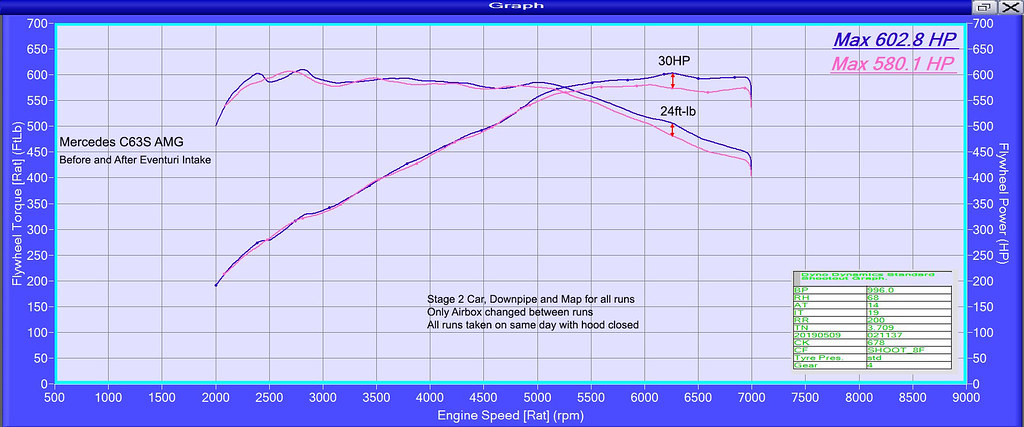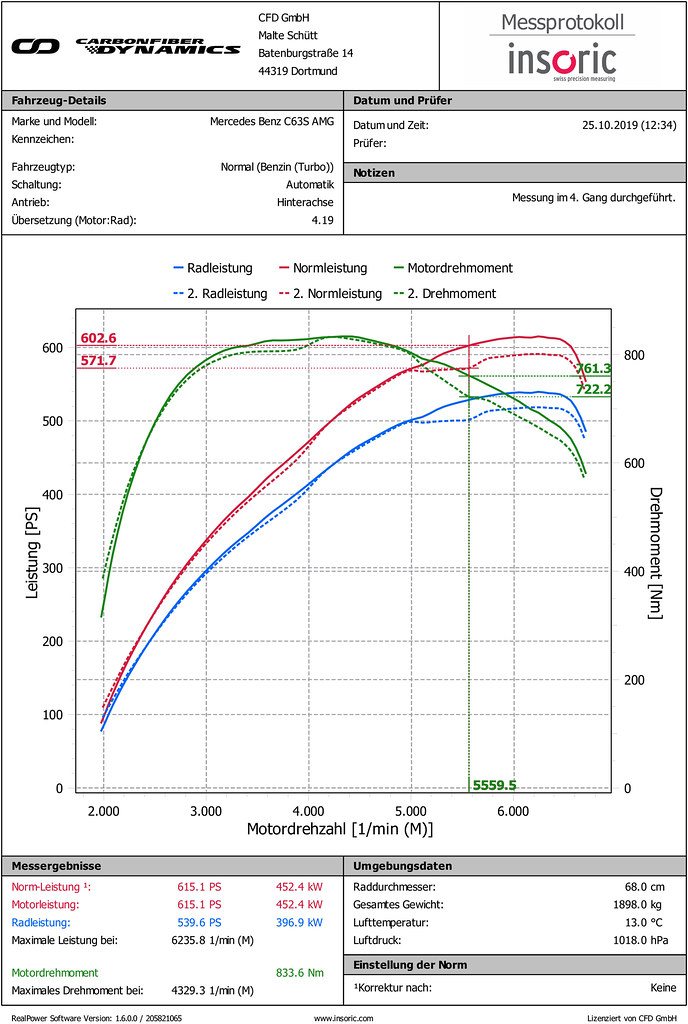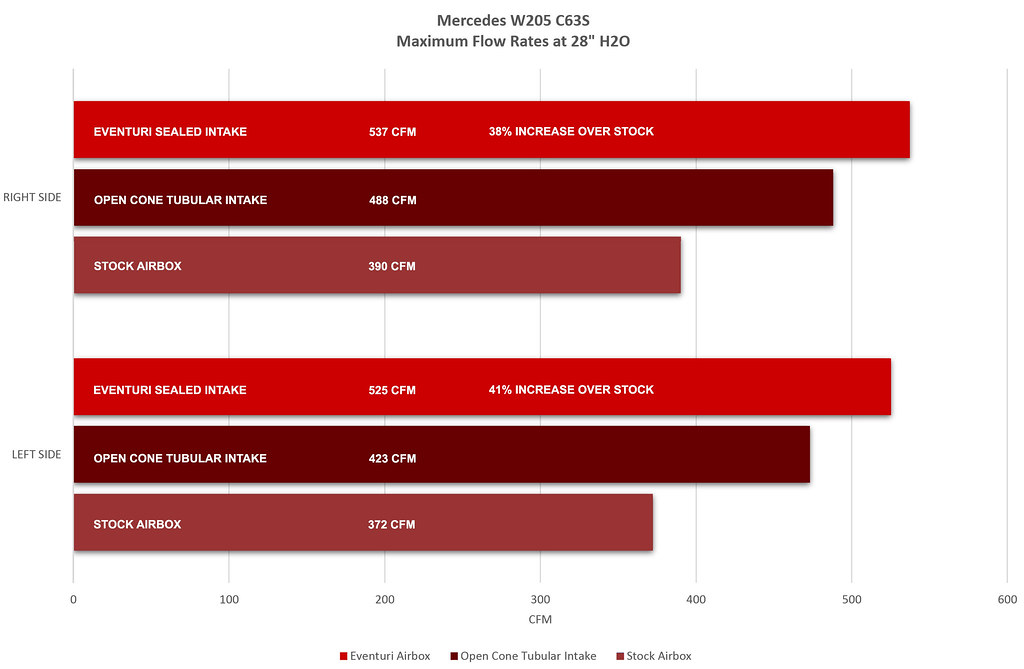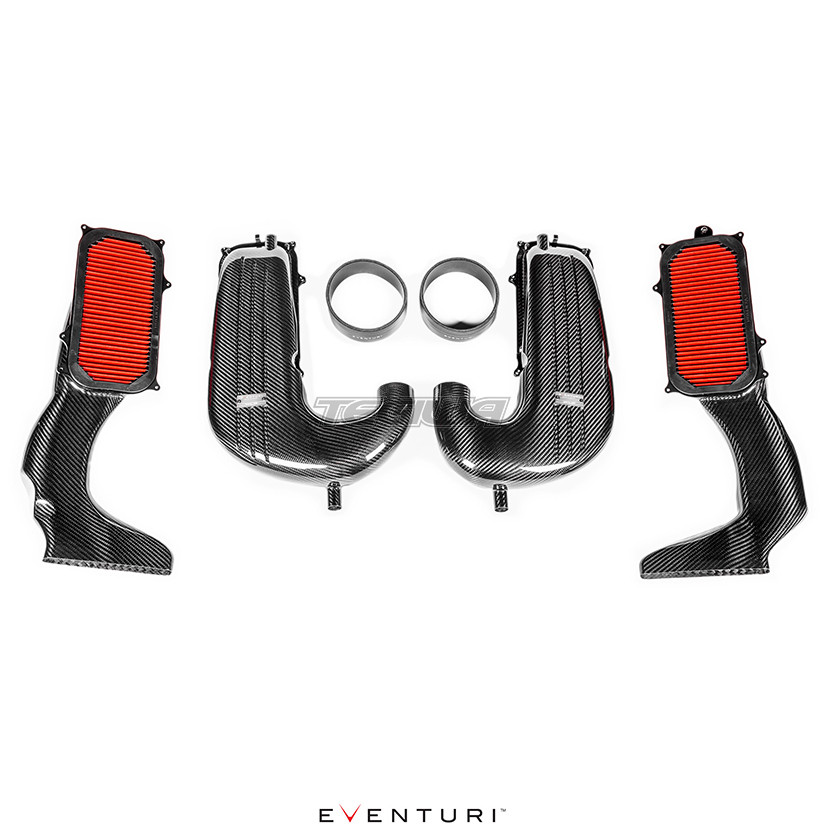Eventuri Pair of Panel Filters Mercedes GLC63S AMG Intake
In stock with our supplier. Please contact us for delivery timescale
£146.88 £122.40 ex. VAT
The Mercedes GLC63S AMG intake system is the culmination of extensive development and testing. Our design brief consisted of 3 main objectives: 1) Increased flow rate. 2) Low intake temperatures. 3) Smooth airflow.
In stock with our supplier. Please contact us for delivery timescale
Description
Performance Increase – Stage 2 : 22-30hp, 20-24ft-lb
Performance Increase – Stock : 10-12hp, 12-15ft-lb
Flowbench Data : Stock Airbox 381 CFM : Eventuri 531 CFM (Average Per Airbox)
The Eventuri GLC63S AMG intake system consists of a number of components engineered to perform a specific purpose and fabricated to the highest of standards. Here are the details for each component and the design ethos behind them:
Each intake system consists of:
- 2 x Carbon Fiber Airbox Lids with Turbo Inlet Transitions
- 2 x Carbon Fiber Airbox Bases with Inlet Duct Transitions
- 2 x Bespoke High Flow Panel Filters
- 2 x CNC Machined Stainless Steel Inlet Flanges
- 4 x CNC Machined Aluminium Filter Flanges
- 2 x CNC Machined MAP Bosses
- 4 x CNC Machined Rubber Mount Holders
- Laser Cut Stainless Steel Bracket Work
The Mercedes GLC63S AMG intake system is the culmination of extensive development and testing. Our design brief consisted of 3 main objectives: 1) Increased flow rate. 2) Low intake temperatures. 3) Smooth airflow. The first objective was met by utilising all of the limited space available in the GLC63S engine bay resulting in a 39% higher flow rate over the stock system. The second objective was met by designing a fully sealed system. The GLC63S engine bay reaches high temperatures with heat sources like the turbos in close proximity to the intake so it is crucial that the intake remains sealed. The final objective was met by designing an organically shaped system with custom rounded panel filters to ensure the airflow path contained no sharp corners and therefore allowed for the flow to remain laminar. With smooth transitions from the filters to the turbo inlets, our intake minimises the formation of turbulence and therefore the turbos are able to operate more efficiently.
With all 3 objectives met, our W205 C63S intake system delivers on all fronts and allows for the turbos to generate boost more efficiently. This results in an improved throttle response and genuine power gains which increase with higher states of tune.
Performance Gain : Stage 2 C63S : 22-30hp, 20-24ft-lb
Performance Gain : Stock C63S : 10-12hp, 12-15ft-lb
Dyno tests were carried out on both a fully stock C63S and a stage 2 C63S which had downpipes and a remap. Below is the dyno graph for the stage 2 car which had the same tune on all runs and only the airbox was changed. Importantly the hood was closed for all runs to simulate road conditions. Dyno testing with the hood open – especially with open cone style intakes does not give a reliable indication of how the intakes are affecting power. On the road the hood is closed and so all the heat from the turbos is trapped in the engine bay. On the C63S this is intense heat which is why a sealed system is so crucial. Dyno testing an open cone system with the hood open will yield gains but once on the road the heat soak will cause a significant detriment to the power with the open cones sucking in the hot air. With higher air temperature being less dense, the turbos will not make as much boost resulting in lower power. Furthermore, once the car is accelerating and the open cone intakes have pulled through the standing hot air present, they will continue to pull in the heat generated by the engine and turbos as they spool. With the engine under load and accelerating, turbos produce a lot of heat which can even be seen with the hot sides glowing red.
Here it can be seen with our fully sealed system that the power increases linearly after 4800rpm where the airflow demand increases and the stock airboxes become a restriction. These performance gains were measured after only changing the stock airbox for the Eventuri intake – all other modifications were present for both the stock airbox and the Eventuri intake.
The gains measured on the dyno translates on the road to increased part throttle and full throttle response with the car pulling much more eagerly to the redline. The testing was done on the same day back-to-back and temperatures were monitored to ensure consistency. The car was tested firstly with the stock intake – hood closed. We then left the car on the dyno and installed the Eventuri. The car was then run again – hood closed. Several runs were carried out with both configurations to get a consistent result.

The following tests were carried out on an Insoric Road Dyno which measures performance data on the road. Tests were carried out in Germany by CF Dynamics on the same stretch of Autobahn on the same day between the stock airbox and the Eventuri system. This particular C63S had a stage 1 tune. As can be seen, after 5000rpm as the flow demand from the engine increases the stock airbox becomes a restriction and gains of 31HP and 39Nm were achieved with the Eventuri intake.

Flow Bench Test Results
We conducted some flow rate tests using a Superflow SF-1020 to measure the maximum flow rate possible at a pressure drop of 28” H2O. Tests were done on the same day in controlled conditions using the same test jig for each system. We tested our sealed intake with our custom filter, the stock airbox with stock filter and an open cone tubular type intake with the intake tube at the same diameter as the stock turbo inlet. Both the left and right side airboxes were tested.
This shows just how restrictive the stock airbox is, which we have managed to improve by up to 41% in maximum possible flow rate. Interestingly the open cone intake, although flowed more than stock, did not flow more than our sealed system. This is because the diameter of the intake tube remains constant all the way from the outlet of the turbo to the cone. So whereas our system dramatically opens in internal volume from outlet to the filter, the open cone system remains at the same smaller cross sectional area. It’s like sucking through a straw vs sucking through a funnel.



